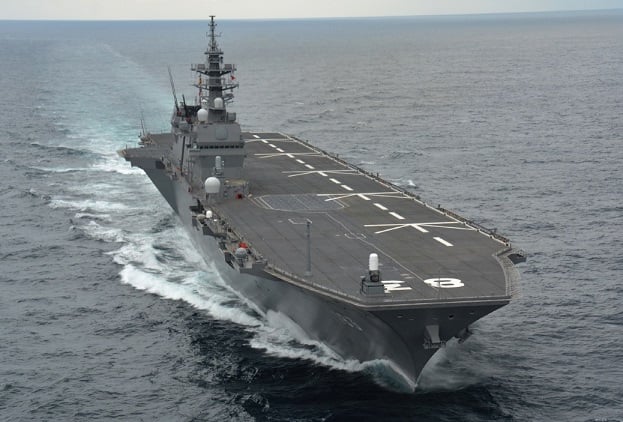
The 24,000-ton JS Izumo (DDH-183) will depart in May from its homeport in Yokosuka, Japan for a series of port visits and exercises running into August.
The ship, “will make stops in Singapore, Indonesia, the Philippines and Sri Lanka before joining the Malabar joint naval exercise with Indian and U.S. naval vessels in the Indian Ocean in July,” reported the wire.
“The aim is to test the capability of the Izumo by sending it out on an extended mission,” a source told Reuters.
“It will train with the U.S. Navy in the South China Sea.”
A U.S. defense official told USNI News on Monday that there were training events with the Japanese Maritime Self Defense Forces planned for the period but did not outline specifics.
Izumo is one of two helicopter carriers the Japanese have built for the stated claim of anti-submarine warfare and humanitarian aid and disaster relief operations. The ship entered into service in 2015 and its sister ship Kaga is set to commission this year.
Both ships field seven Mitsubishi-built SH-60k ASW helicopters and seven AgustaWestland MCM-101 mine countermeasure (MCM) helicopters, according to U.S. Naval Institute’s Combat Fleets of the World. Both ships can also accommodate U.S. Marine Corps MV-22 Osprey tilt-rotor aircraft.
Japanese officials have said the threat of an expanded Chinese submarine fleet was a key driver of Japan developing the ship class.
Izumo’s ASW capability fits in with the goals of Malabar 2017 trilateral exercise with India and the U.S., according to a December interview with U.S. 7th Fleet commander Adm. Joseph Aucoin with the Press Trust of India.
Aucoin promised a larger and more complex ASW exercise in 2017 that would combine new capabilities of the Indian and U.S. forces in the region – like the Indian and U.S. P-8A and Indian P-8I ASW aircraft.
Beijing, for its part, has been vocally opposed to Japan operating warships in the South China Sea and leaned on memories of Imperial Japanese actions in World War II.
“Japan should reflect upon rather than forget what it has done during the aggression, act and speak cautiously on issues concerning the East China Sea and the South China Sea, and make more efforts to increase mutual trust with its neighbors and promote regional peace and stability instead of sowing discord,” Chinese Ministry of Foreign Affairs spokesman Hong Lei said last year.
The deployment comes as the Trump administration has said it will be more aggressive in ensuring freedom of international waterways in the region.
In addition to the size of the ship, the helicopter carriers name sends its own message.
“The original Izumo, an armored cruiser that participated in the Battle of Tsushima, was purchased with reparations from the first Sino-Japanese War,” wrote USNI News contributor Kyle Mizokami.“There is little doubt all parties, particularly the Chinese, are aware of the lineage.”





